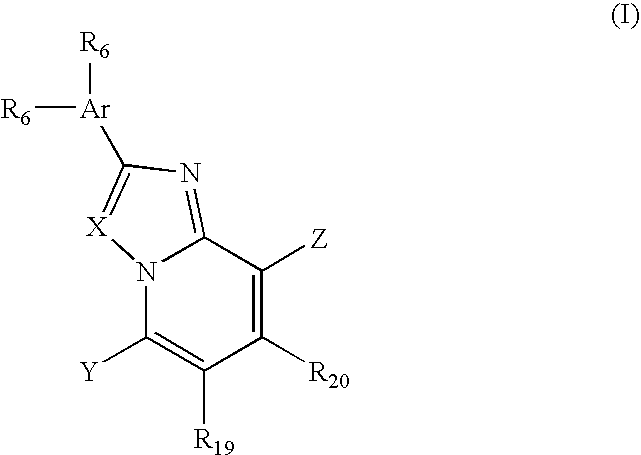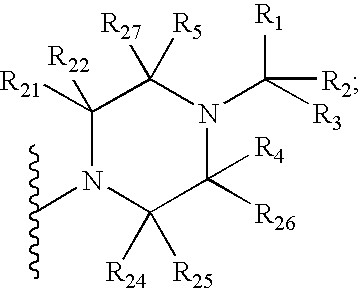Piperazinylimidazopyridine and piperazinyltriazolopyridine antagonists of gonadotropin releasing hormone receptor
a technology of gonadotropin and antagonists, which is applied in the field of gonadotropin releasing hormone, can solve the problems of immediate drop in plasma lh levels, undesirable superagonism process, and increase in disease symptoms
- Summary
- Abstract
- Description
- Claims
- Application Information
AI Technical Summary
Problems solved by technology
Method used
Image
Examples
example 1
[0391]
[0392] 6-Bromo-quinoxaline: In a round bottom flask under nitrogen was combined 4-bromo-benzene-1,2-diamine (2.01 g, 10.7 mmol), methanol (50 mL), and glyoxal (40% by wt. 3.1 mL, 26.9 mmol) and the resulting solution stirred overnight. The reaction was then concentrated in vacuo and purified by flash column chromatography on silica gel using 5-10% ethyl acetate in dichloromethane as eluant to yield 1.14 g (50% yield) of 6-Bromo-quinoxaline as a yellow-orange solid. 1H NMR (DMSO-d6): 9.00 (d,2H,J=2.8 Hz), 8.36 (d,1H,J=2.2 Hz), 8.07 (d,1H,J=9.0 Hz), 8.02 (dd,1H,J=8.8,2.1 Hz). CHN for C8H5BrN2: calc. C 45.97, H 2.41, N 13.4; found C 45.99, H 2.09, N 13.09. LC / MS (Method A): r.t.=1.10 min., purity=99%, calculated mass=208, [M+H]+=209 / 211. HPLC (Method B): r.t.=7.4 min., purity=98.52% at 210-370 and 98.8% at 322 nm.
example 2
[0393]
[0394] 6-Vinyl-quinoxaline: A mixture of 6-Bromo-quinoxaline (1.05 g, 5.02 mmol), palladium tetrakistriphenylphosphine (0.232 g, 0.2 mmol), and lithium chloride (0.639 g, 15.1 mmol) in dry toluene (50 mL) under nitrogen was treated with tributylvinyl tin (4.4 mL, 15.1 mmol) and heated to 100° C. for three hours. After cooling to room temperature the mixture was partitioned between ethyl acetate (200 mL) and water (100 mL). The aqueous layer was discarded and the organics washed with brine (2×100 mL), dried with magnesium sulfate, filtered, and concentrated to dryness on a rotary evaporator. Purification by flash column chromatography on silica gel using 10% ethyl acetate in dichloromethane as eluant yielded 680 mg (87% yield) of 6-Vinyl-quinoxaline as a light orange solid. 1H NMR (DMSO-d6): 8.92 (dd,2H,J=14.1,1.9 Hz), 8.10 (m,3H), 7.03 (dd,1H,J=17.7,10.9 Hz), 6.15 (dd,1H,J=17.7,0.4 Hz), 5.52 (d,1H,J=11.1 Hz). LC / MS (Method A): r.t.=1.14 min., purity=99%, calculated mass=156, [...
example 3
[0395]
[0396] Quinoxaline-6-carbaldehyde: To a mixture of 6-Vinyl-quinoxaline (0.68 g, 4.35 mmol) in dioxane (44 mL) and water (35 mL) was added osmium tetraoxide (2.5% wt in t-BuOH, 2.18 mL, 0.17 mmol) followed by sodium periodate (2.79 g, 13.1 mmol) and the reaction stirred for 3 h. The solution was diluted with ethyl acetate (150 mL) and then washed with water (3×75 mL) followed by brine (75 mL). The organics were dried with magnesium sulfate, filtered, and concentrated in vacuo. Purification by flash column chromatography on silica gel using 10-20% ethyl acetate in dichloromethane as eluant yielded 470 mg (68% yield) of Quinoxaline-6-carbaldehyde as a white solid. 1H NMR (DMSO-d6): 10.30 (s,1H), 9.11 (d,2H,J=1.9 Hz), 8.74 (d,1H,J=1.4 Hz), 8.26 (m,2H). LC / MS (Method A): r.t.=0.69 min., purity=94.8%, calculated mass=158, [M+H]+=159.
PUM
| Property | Measurement | Unit |
|---|---|---|
| Force | aaaaa | aaaaa |
| Pharmaceutically acceptable | aaaaa | aaaaa |
Abstract
Description
Claims
Application Information
 Login to View More
Login to View More - R&D
- Intellectual Property
- Life Sciences
- Materials
- Tech Scout
- Unparalleled Data Quality
- Higher Quality Content
- 60% Fewer Hallucinations
Browse by: Latest US Patents, China's latest patents, Technical Efficacy Thesaurus, Application Domain, Technology Topic, Popular Technical Reports.
© 2025 PatSnap. All rights reserved.Legal|Privacy policy|Modern Slavery Act Transparency Statement|Sitemap|About US| Contact US: help@patsnap.com



